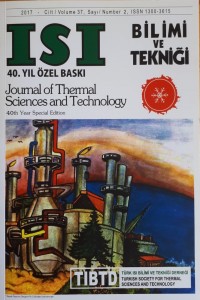Öz
Kaynakça
- Azevedo, L. F. A., Webb, B.W. and Queiroz, M., 1994, Pulsed Air Jet Impingement Heat Transfer, Exp. Thermal Fluid Sci., 8, 206–213.
- Collucci, D. W. and Viskanta, R., 1996, Effect of Nozzle Geometry on Local Convective Heat Transfer to a Confined Impinging Air Jet, Experimental Thermal and Fluid Science, 13, pp. 71 – 80.
- Demircan, T. and Turkoglu, H., 2010, The Numerical Analysis of Oscillating Rectangular Impinging Jets, Numerical Heat Transfer, Part A, 58, 146-161.
- Goldstein, R. J. and Timmers, J. F., 1982, Visualization of Heat Transfer from Arrays of Impinging Jets, International Journal of Heat and Mass Transfer, 25, 1857 – 1868.
- Goppert S., Gourtler T., Mocikat H. and Herwig, H., 2004, Heat Transfer Under a Precessing Jet: Effects of Unsteady Jet Impingement. International Journal of Heat and Mass Transfer, 47, 2795–2806.
- Liu T. and Sullivan J.P., 1996, Heat Transfer and Flow Structures in an Excited Circular Impinging Jet, Int. J. Heat Mass Transfer 39 (17), 3695–3706.
- Miladin, E.C. and Zumbrunnen, D. A., 1997, Local Convective Heat Transfer to Submerged Pulsating Jets, Int. J. Heat Mass Transfer, 40 (14), 3305–3321.
- O’Donovan T. S. and Murray. B., 2008, Fluctuating Fluid Flow and Heat Transfer of an Obliquely Impinging Air Jet, International Journal of Heat and Mass Transfer, 51, 25-26.
- Poh H. J, Kumar K. and Majumdar A. S., 2005, Heat transfer from a pulsed laminar impinging jet, International Communications in Heat and Mass Transfer, 32, 1317–1324.
- Zumbrunnen, D. A. and Aziz, M., 1993, Convective Heat Transfer Enhancement Due to Intermittency in an Impinging Jet, J. Heat Transfer, 115 91–98.
Öz
In this study, the flow and heat transfer characteristics of pulsating circular air jets impinging on a flat surface were numerically analyzed. The jet velocity pulsated in time. The objective of the work is to investigate the influence of the jet Reynolds number, pulsation amplitude and pulsation frequency on the rate of heat transfer from the target hot surface. For the analysis, a computer program, based on the control volume method and SIMPLE algorithm, was developed. Laminar flow with the time averaged jet Reynolds numbers between 300 and 700 were analyzed. The pulsation amplitude is ranged between 0.0V0 (steady jet) and 0.8V0 (m/s) (V0 is period averaged jet velocity), and the frequency is ranged between 1 and 6 Hz. The nozzle-to-plate distance was kept constant at H/d=3. From the simulation results, it was observed that at any instant of the pulsation period, the local Nusselt number is maximum at the stagnation point, and it decreases along the plate. This decrease in the local Nusselt number is not monatomic as in the steady jet cases. It has local maximum and minimum values (fluctuations) due to the moving recirculating flow regions along the bottom plate. At low frequencies, the time (period) averaged stagnation point Nusselt numbers are lower than the corresponding steady jet Nusselt numbers. However, with the increasing frequency, the stagnation point Nusselt number increases and become higher than the steady jet Nusselt number.
Anahtar Kelimeler
Kaynakça
- Azevedo, L. F. A., Webb, B.W. and Queiroz, M., 1994, Pulsed Air Jet Impingement Heat Transfer, Exp. Thermal Fluid Sci., 8, 206–213.
- Collucci, D. W. and Viskanta, R., 1996, Effect of Nozzle Geometry on Local Convective Heat Transfer to a Confined Impinging Air Jet, Experimental Thermal and Fluid Science, 13, pp. 71 – 80.
- Demircan, T. and Turkoglu, H., 2010, The Numerical Analysis of Oscillating Rectangular Impinging Jets, Numerical Heat Transfer, Part A, 58, 146-161.
- Goldstein, R. J. and Timmers, J. F., 1982, Visualization of Heat Transfer from Arrays of Impinging Jets, International Journal of Heat and Mass Transfer, 25, 1857 – 1868.
- Goppert S., Gourtler T., Mocikat H. and Herwig, H., 2004, Heat Transfer Under a Precessing Jet: Effects of Unsteady Jet Impingement. International Journal of Heat and Mass Transfer, 47, 2795–2806.
- Liu T. and Sullivan J.P., 1996, Heat Transfer and Flow Structures in an Excited Circular Impinging Jet, Int. J. Heat Mass Transfer 39 (17), 3695–3706.
- Miladin, E.C. and Zumbrunnen, D. A., 1997, Local Convective Heat Transfer to Submerged Pulsating Jets, Int. J. Heat Mass Transfer, 40 (14), 3305–3321.
- O’Donovan T. S. and Murray. B., 2008, Fluctuating Fluid Flow and Heat Transfer of an Obliquely Impinging Air Jet, International Journal of Heat and Mass Transfer, 51, 25-26.
- Poh H. J, Kumar K. and Majumdar A. S., 2005, Heat transfer from a pulsed laminar impinging jet, International Communications in Heat and Mass Transfer, 32, 1317–1324.
- Zumbrunnen, D. A. and Aziz, M., 1993, Convective Heat Transfer Enhancement Due to Intermittency in an Impinging Jet, J. Heat Transfer, 115 91–98.
Ayrıntılar
| Birincil Dil | İngilizce |
|---|---|
| Konular | Makine Mühendisliği |
| Bölüm | Araştırma Makalesi |
| Yazarlar | |
| Yayımlanma Tarihi | 31 Ekim 2017 |
| Yayımlandığı Sayı | Yıl 2017 Cilt: 37 Sayı: 2 |


